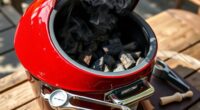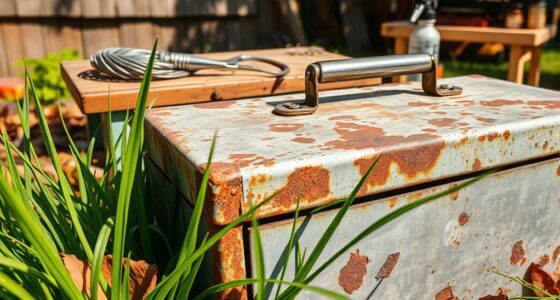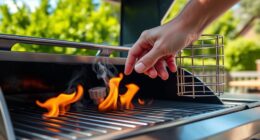Desooting your wood oven is essential for safety and efficiency, as soot and creosote buildup can cause poor airflow, smoke issues, and fire hazards. You should inspect regularly for signs like soot on surfaces, strange odors, or uneven heating. Use proper tools like brushes and gloves, and follow step-by-step safety tips to clean thoroughly. For best results and to prevent damage, keep an eye on common mistakes and know when to seek professional help—more helpful tips await you.
Key Takeaways
- Regular desooting prevents soot buildup, improves airflow, and enhances oven safety and efficiency.
- Use proper tools like brushes, scrapers, and protective gear for effective cleaning.
- Burn well-seasoned, hardwood fuel to minimize soot formation and promote cleaner fires.
- Ventilate workspace and manage airflow carefully to ensure thorough soot removal and safety.
- Seek professional help if creosote persists or if ventilation issues occur despite regular cleaning.
Why Desooting Is Essential for Your Wood Oven
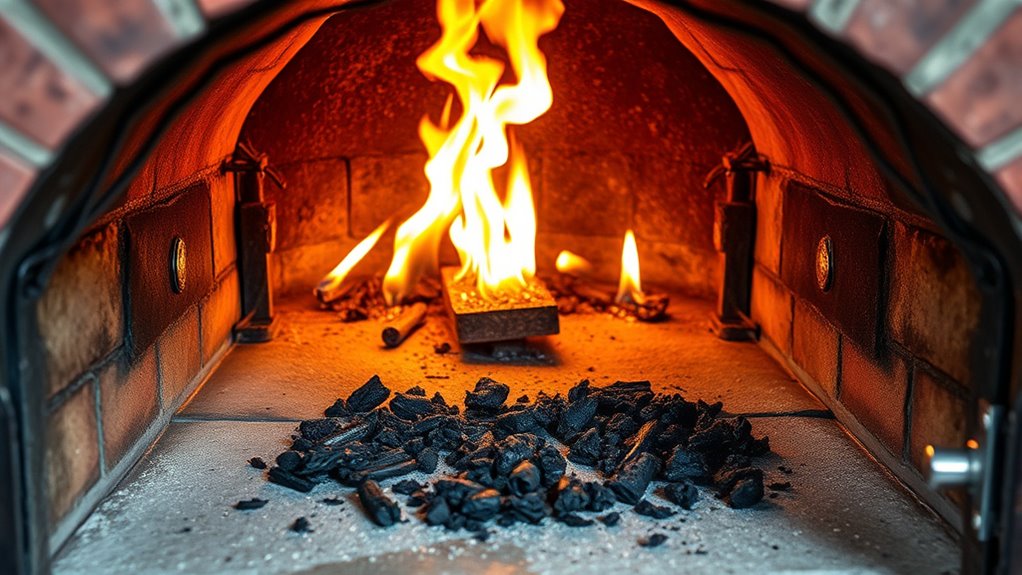
Regular desooting is essential because built-up soot can considerably impair your wood oven’s performance. When chimney buildup occurs, it restricts airflow, making it harder for your oven to operate efficiently. This decreased airflow results in incomplete combustion, which wastes fuel and reduces heat output. Over time, soot accumulation can also cause dangerous blockages or even fires if left unchecked. By regularly removing the soot, you maintain ideal airflow, ensuring your wood oven burns cleaner and more efficiently. Proper color accuracy can also help you better monitor the cleanliness of your chimney and identify early signs of buildup. This not only saves you money on fuel but also extends the lifespan of your oven. In short, consistent desooting keeps your wood oven running smoothly, maximizes fuel efficiency, and helps you enjoy safer, more effective heating.
Signs Your Wood Oven Needs a Good Cleaning

Knowing when your wood oven needs a thorough cleaning can save you from inefficient heating and potential safety hazards. One clear sign is visible creosote buildup during a chimney inspection; a thick, sticky residue indicates it’s time to clean. You might also notice smoke lingering inside the room or a strong odor, both signs that airflow is compromised. Uneven or slow heating can suggest soot buildup affecting heat transfer. Regular wood stove maintenance helps prevent dangerous blockages and improves efficiency. If you see soot accumulating on the oven’s interior or notice increased ash in the firebox, it’s a good indicator that your oven needs a cleaning. Additionally, ensuring proper installation and venting is vital for safe operation. Addressing these signs promptly ensures peak performance and safety.
How Often Should You Desoot Your Oven?

Most wood oven owners should desoot their units at least once a year, but the frequency can vary based on usage and fuel selection. If you use your oven frequently or burn softer woods, you might need to desoot more often to maintain ideal airflow. Regular chimney maintenance helps prevent excessive soot buildup, reducing fire hazards and improving efficiency. For infrequent use or when burning well-seasoned, dense woods, you may extend the interval between desooting sessions. Keep an eye on smoke production and oven performance—more smoke or reduced heat indicates it’s time to clean out the soot. Consistent desooting ensures proper chimney maintenance, improves combustion, and prolongs your oven’s lifespan. Preppy Dog Names are also a popular choice among pet owners, reflecting style and personality—similar to how choosing the right name can enhance your dog’s character. Adjust your schedule accordingly to keep your oven running safely and efficiently.
Tools and Materials Needed for Desooting
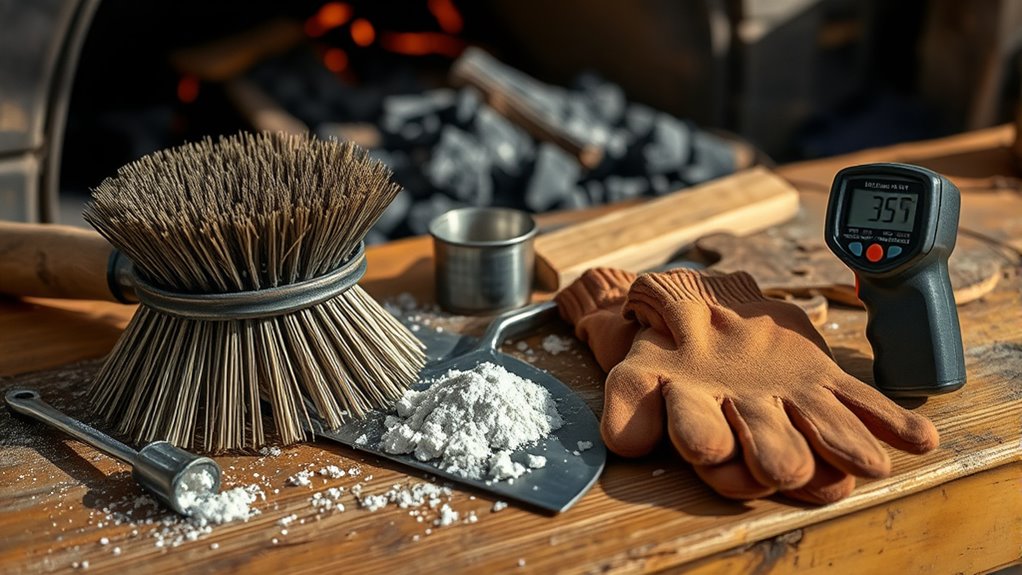
To effectively desoot your wood oven, you’ll need the right tools and materials on hand. Having these ready guarantees a smooth process and keeps you safe. First, invest in a pair of fire resistant gloves to protect your hands from heat and soot. Second, a sturdy metal scraper is essential for removing buildup without damaging the oven’s surfaces. Third, keep a wire brush nearby to clean crevices and stubborn spots. Fourth, gather a damp cloth or sponge for wiping down the interior once you’ve removed the soot. Additionally, selecting the appropriate cleaning tools ensures thorough maintenance and prevents damage to delicate oven surfaces. With these tools, you’ll be prepared to tackle the desooting process efficiently and more effectively, making your oven maintenance easier and safer.
Step-by-Step Guide to Safely Desoot Your Wood Oven
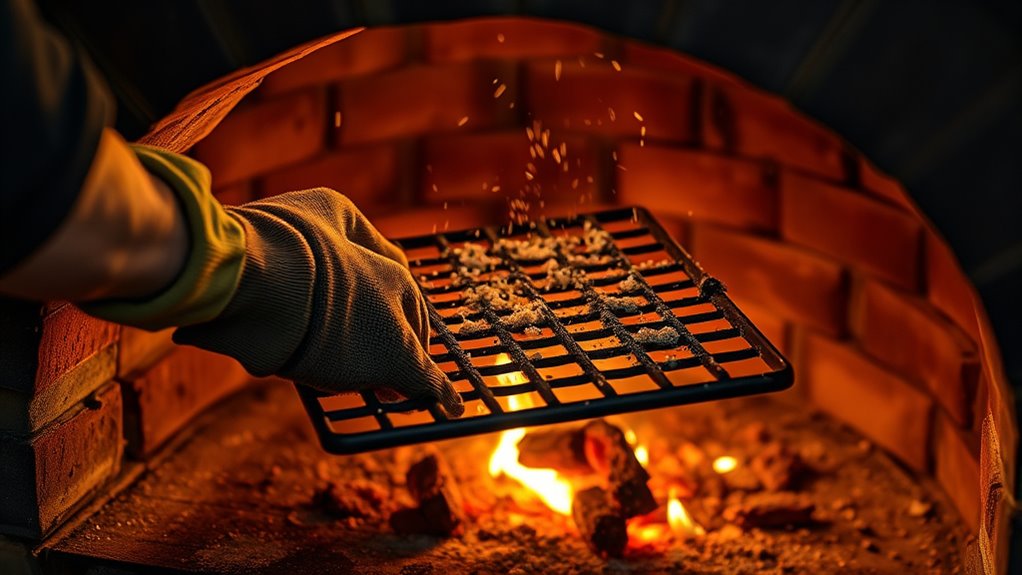
Before you start desooting, gather all the necessary tools to make the process easier and safer. Next, guarantee you follow proper safety steps, like wearing gloves and eye protection. This will help you clean your oven effectively while avoiding any accidents. Additionally, understanding food safety practices can help prevent contamination when handling debris and residues inside the oven.
Gather Necessary Tools
Gathering the right tools is essential for a safe and effective desooting process. You want to guarantee you’re prepared before starting. Here are four key tools you’ll need:
- Fire resistant gloves – protect your hands from heat and sharp debris.
- Chimney brush – essential for scrubbing and removing soot buildup inside the chimney.
- Dustpan and brush – for collecting soot and debris from around the oven.
- Vacuum – a shop vac works well to clean out loose soot and dust afterward.
Having these tools ready will make your desooting safer and more efficient. Make sure your chimney brush fits your chimney size, and always wear fire resistant gloves to prevent burns. Proper preparation is the first step to a successful cleaning.
Follow Proper Safety Steps
Ensuring safety when desooting your wood oven is essential to prevent accidents and injuries. Always wear protective gear, like gloves and safety glasses, to guard against hot ash and debris. Follow fire safety protocols by keeping a fire extinguisher nearby in case of unexpected flare-ups. Make sure your workspace is well-ventilated—use ventilation tips such as opening windows or using exhaust fans to disperse dust and fumes. Never rush the process, and avoid leaving the oven unattended while cleaning. Check for any blockages or hazards that could cause smoke or fire. Properly dispose of ash and soot in a metal container away from flammable materials. Additionally, understanding the types of soot can help you identify when a thorough desooting is necessary. These safety steps keep you protected and ensure a smooth, risk-free desooting experience.
Tips for Maintaining a Soot-Free Oven
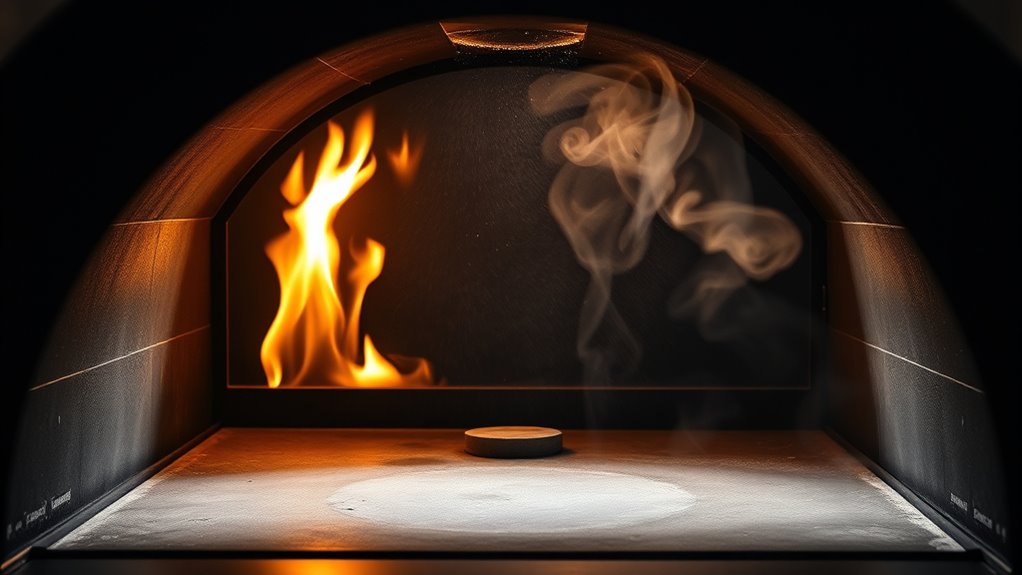
To keep your oven soot-free, make sure to clean your chimney regularly to prevent buildup. Always use the right type of fuel to minimize excess smoke and creosote. These simple steps can help maintain a clean, efficient oven with less hassle. Additionally, using fresh, high-quality fuel can reduce the formation of spoiled materials, which contribute to soot accumulation.
Regular Chimney Cleaning
Have you ever wondered why your wood oven builds up soot so quickly? Regular chimney cleaning is essential to prevent creosote buildup and ensure safe operation. Here are four tips to keep your chimney clean and your oven soot-free:
- Schedule routine chimney inspections to spot early signs of creosote buildup.
- Use a chimney brush to remove soot and creosote deposits thoroughly.
- Check for obstructions like bird nests or debris that can hinder proper airflow.
- Consider professional cleaning at least once a year, especially after heavy use.
Keeping the chimney clean not only improves efficiency but also reduces fire risk. Regular maintenance helps you enjoy a cleaner, safer wood oven with less soot buildup over time.
Use Proper Fuel
Using the right type of fuel is key to keeping your wood oven clean and soot-free. Proper fuel guarantees efficient burning and minimizes soot buildup. Focus on firewood selection by choosing seasoned, dry wood with low moisture content—wet wood produces more smoke and creosote. Hardwoods like oak, maple, and hickory burn hotter and cleaner than softwoods. Avoid using treated or painted wood, as chemicals can produce harmful residues and increase soot. Proper fuel also means stacking your firewood properly to promote good airflow, ensuring complete combustion. Regularly inspect your firewood for mold or pests. Additionally, seasoned firewood helps ensure optimal burning conditions. By selecting quality, seasoned firewood and burning it correctly, you reduce soot formation, keep your oven cleaner, and enjoy more efficient, safer fires.
Common Mistakes to Avoid During Desooting

Avoid rushing the desooting process, as doing so can cause damage to your wood oven. Jumping ahead can also hinder proper soot removal and ventilation improvements. To prevent common mistakes:
- Skipping thorough cleaning of ash and creosote buildup, which can block airflow.
- Using excessive heat too quickly, risking damage to oven components.
- Ignoring soot prevention techniques like proper airflow management.
- Neglecting to monitor vent and chimney conditions, which affects ventilation improvements.
- Overlooking the importance of airless paint sprayer maintenance, which can lead to inefficient cleaning and potential damage to your equipment.
Focusing on steady, controlled heat and regular cleaning helps prevent excessive soot buildup. Proper ventilation is essential; ensure vents are open and unobstructed to improve airflow. Staying attentive to these details prevents costly mistakes and ensures your oven stays in top shape.
When to Call in a Professional for Deep Cleaning
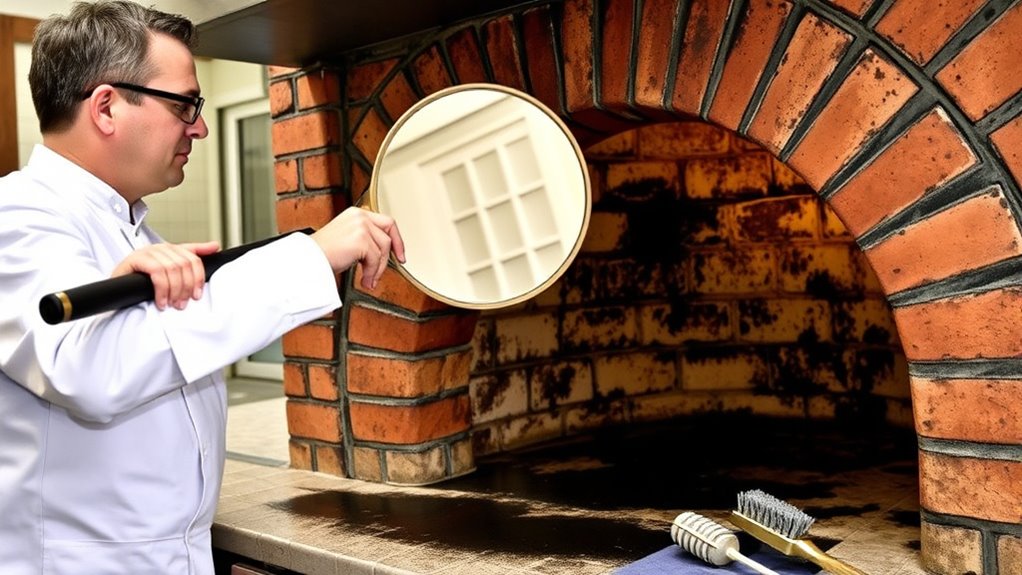
Knowing when to call in a professional for deep cleaning is essential to maintaining your wood oven’s performance and safety. If you notice persistent creosote buildup, smoke escaping from the chimney, or reduced airflow, it’s time to seek expert help. A professional chimney inspection can identify hidden hazards and guarantee your ventilation system is functioning ideally. Additionally, if you’ve experienced frequent fires or odors, deep cleaning by a specialist can prevent potential hazards and improve overall ventilation improvements. Don’t wait until minor issues become major problems; regular professional cleanings can prolong your oven’s lifespan and keep your home safe. Trusting experts ensures thorough removal of stubborn deposits and proper assessment of your chimney and ventilation system. The use of automation in business intelligence can further optimize maintenance schedules and monitor system health remotely.
Frequently Asked Questions
Can Desooting Improve My Oven’s Cooking Performance?
Yes, desooting your wood oven can improve cooking efficiency and heat retention. When you remove soot buildup, heat flows more effectively, ensuring consistent temperatures. This means your oven heats up faster and maintains steady heat, leading to better-cooked meals. Regular desooting prevents blockages, improves airflow, and keeps your oven functioning preferably, so your cooking results are more reliable and delicious every time.
Is It Safe to Desoot My Oven Without Professional Help?
You shouldn’t try to desoot your oven without professional help; it’s like walking a tightrope without a safety net. For DIY safety, follow manufacturer instructions carefully, but if you’re unsure, it’s best to call in professional services. They have the right tools and expertise to safely remove soot buildup without risking damage or injury. When in doubt, it’s smarter to seek expert help than to take a risky shortcut.
What Are the Environmental Impacts of Desooting Methods?
Desooting your wood oven can impact the environment by contributing to air pollution and chemical emissions if done improperly. When you use harsh chemicals or burn residual soot, you release pollutants into the air, harming air quality and health. To minimize these effects, opt for natural cleaning methods and guarantee proper ventilation. Being mindful of your desooting practices helps reduce your environmental footprint and keeps the air cleaner.
How Do I Prevent Excessive Soot Buildup in the Future?
To keep your oven shining bright and minimize soot buildup, stick to a regular cleaning schedule—scheduling cleaning frequency helps prevent excessive soot accumulation. Use proper wood and guarantee complete combustion, which naturally aids soot prevention. Avoid overloading the oven and maintain proper airflow. By staying proactive with these habits, you’ll enjoy a cleaner oven, more efficient cooking, and less fuss, making every use a delightful experience.
Are There Eco-Friendly Desooting Products Available?
Yes, eco-friendly alternatives for desooting your wood oven are available. You can use sustainable cleaning products made from natural ingredients like baking soda, vinegar, or lemon juice, which effectively remove soot without harming the environment. These options are safer for you and the planet, reducing chemical use. Regularly maintaining your oven with these sustainable cleaning products helps prevent soot buildup and keeps your oven functioning efficiently.
Conclusion
Regular desooting keeps your wood oven running efficiently and safely. Did you know that neglecting soot buildup can reduce your oven’s efficiency by up to 30%? By following these simple steps, you’ll enjoy better heat retention and longer-lasting equipment. Staying on top of cleaning isn’t just about performance—it’s about safety too. So, make desooting part of your routine, and enjoy warm, soot-free fires all season long!

